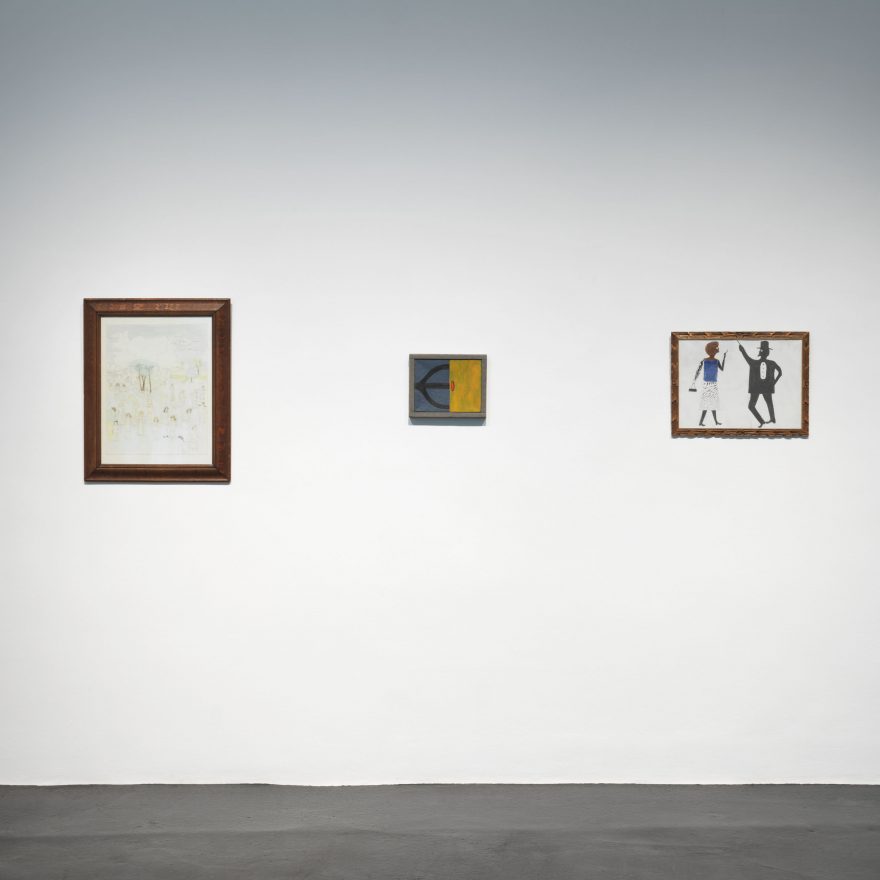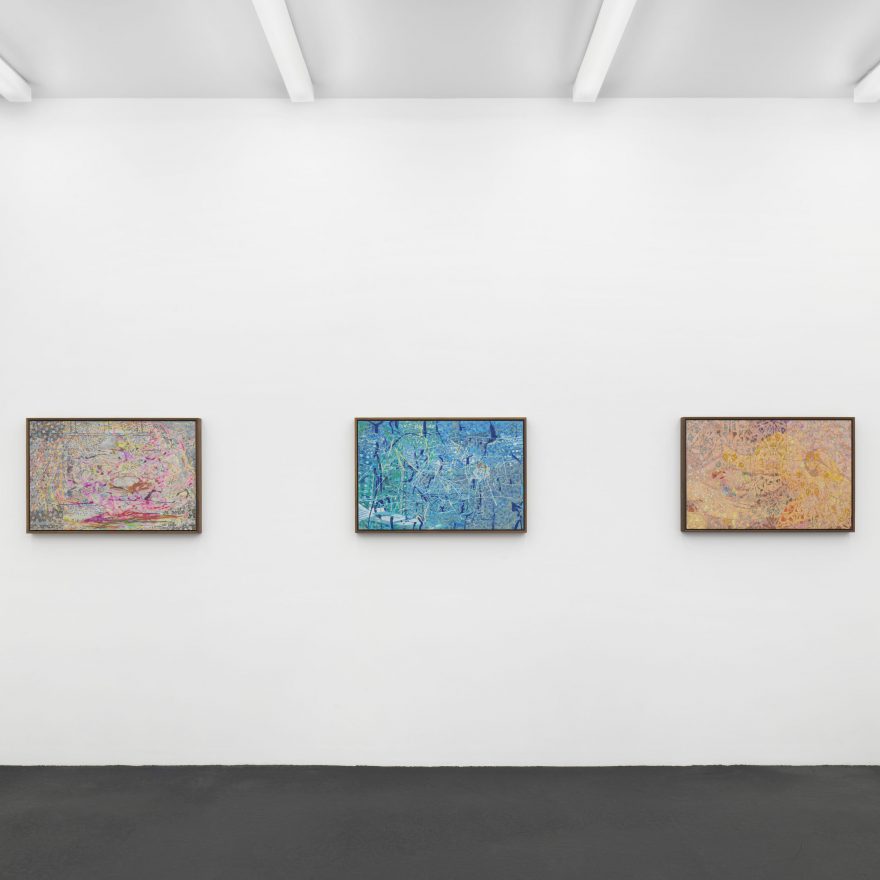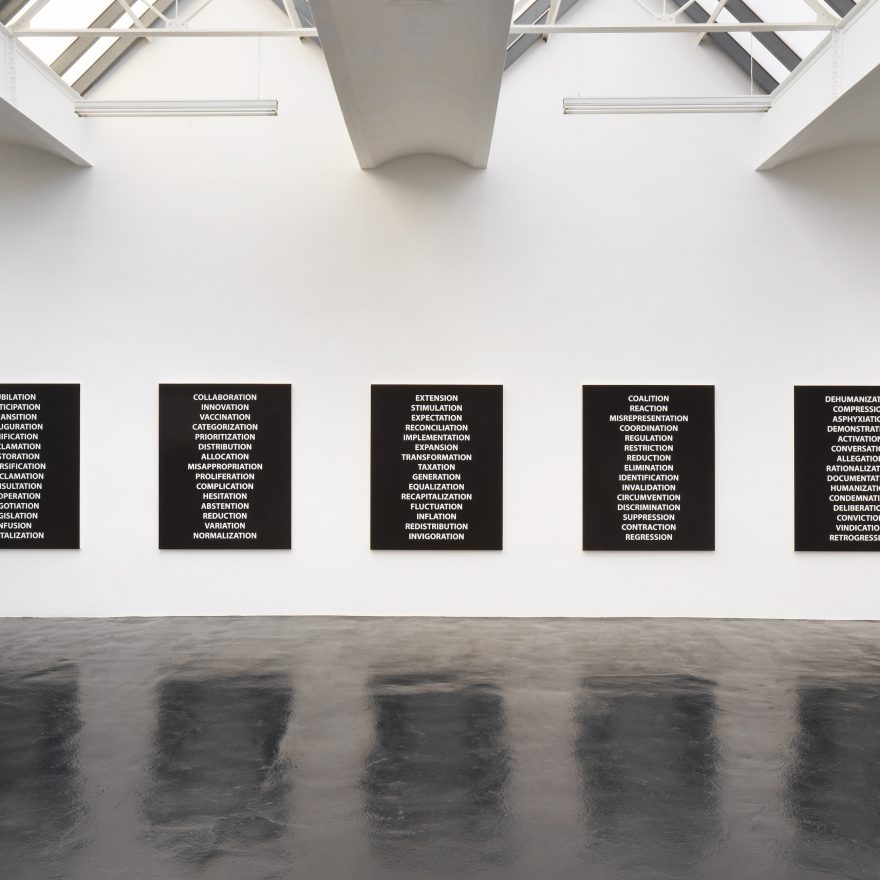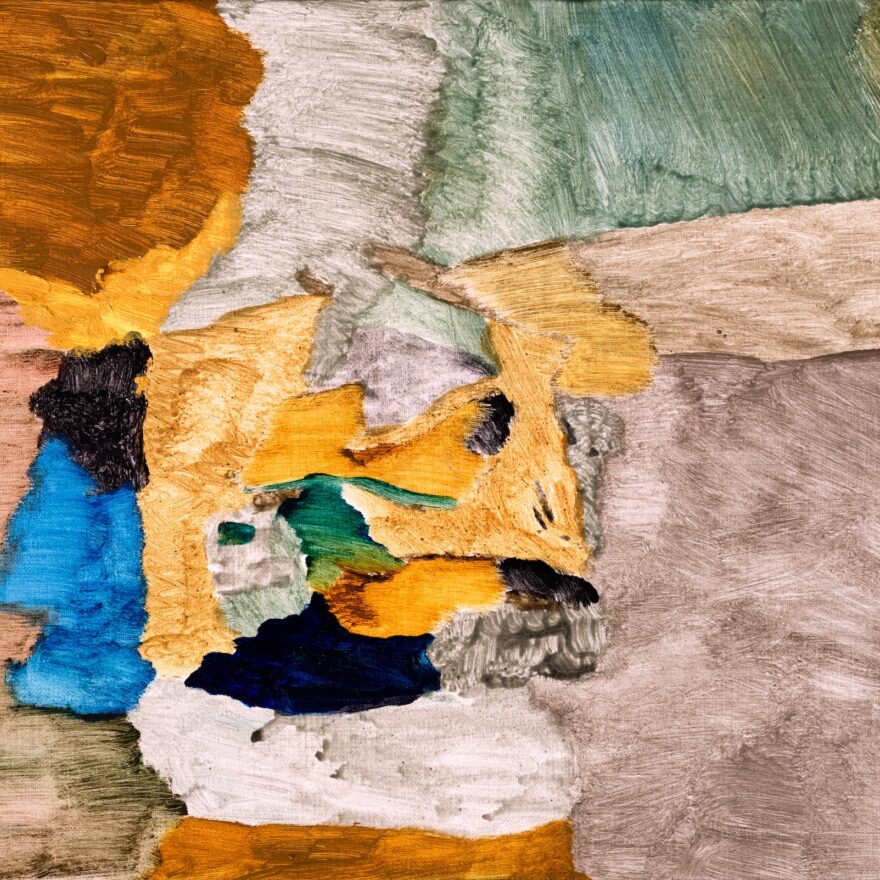Published 12 NOV 2024
Simon Starling
Project for an Exhibition, Part 1: Time Takes (Scenario for a Conversation)
Opening – 22 NOV 2024, 6-9 pm
23 NOV until 1 FEB 2025
Linienstraße 155, 10115 Berlin
In Project for an Exhibition, Part 1: Time Takes (Scenario for a Conversation), Simon Starling’s eighth solo exhibition with neugerriemschneider, the artist dedicates a series of sculptural portraits to the integral role that collaboration plays in his body of work. A group of minimal, abstracted figures presents key accomplices from throughout the artist’s career – architect and astronomer Mike Davies, marine biologist Sam Bowser, playwright and director Graham Eatough, pianolist Rex Lawson, designer Fulvio Ferrari, conservator Sherry Phillips and artist Rasmus Nielsen – standing as tributes to the diverging apprehensions of time that each embodies, and to the cross-disciplinary expertise embedded within Starling’s research-intensive projects. Surveying an artistic approach of over three decades, the likenesses find their counterparts in a collection of photographs and sculptures that stems from the contributions of those depicted.

installation view: Simon Starling, Project for an Exhibition, Part 1: Time Takes (Scenario for a Conversation), November 23, 2024 – February 1, 2025, neugerriemschneider, Berlin
© Simon Starling. Courtesy the artist and neugerriemschneider, Berlin. Photo: Jens Ziehe, Berlin

The cultivated ethos of collaboration has indelibly marked Starling’s practice, forming and informing it since its inception. As a trained photographer and artist whose far-reaching complexes of historical and cultural inquiry often pull from specialized, obscure or rarefied bases of knowledge, he has come to regularly call upon the technical competencies of others to help in faithfully, thoroughly actualizing his concepts. An acute awareness of his proficiencies is alchemized into a pointed strength under Starling’s care, with guidance and close exchange allowing him forays into new worlds. Here, the transformation and translation that characterize Starling’s production expand and extend to his process itself. It too undergoes a metamorphosis, crucially integrating the artist’s facilities with those of his collaborators, fusing them to something uniquely generative, their dialog creating work that grows beyond just the sum of its parts.

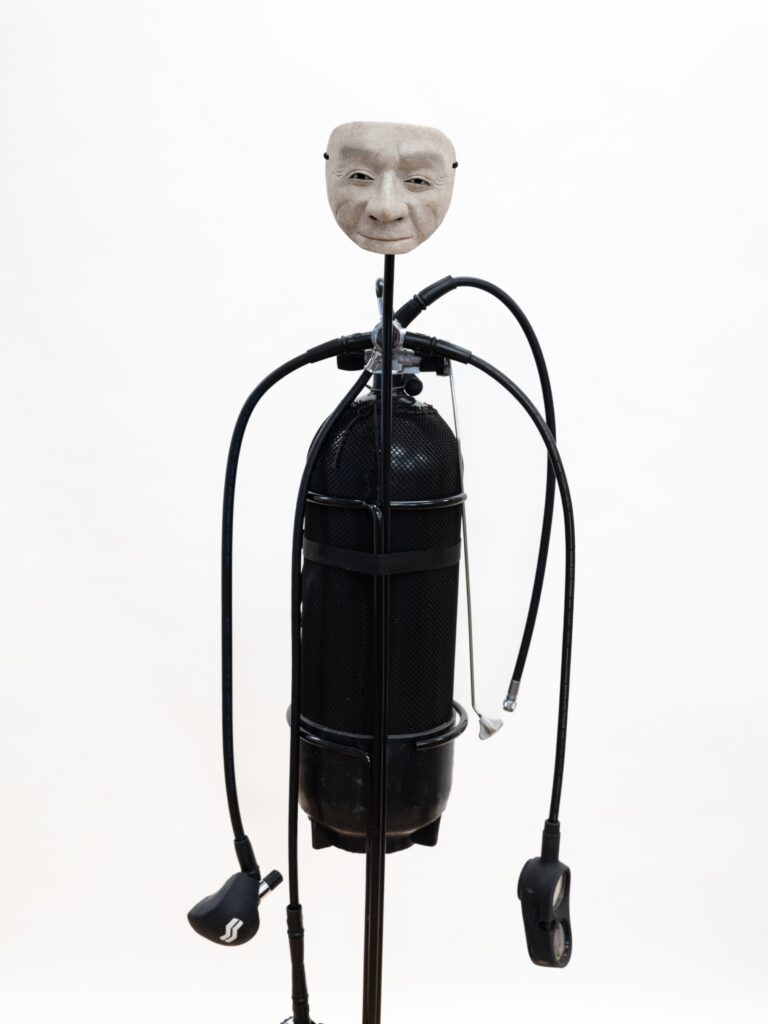


installation view: Simon Starling, Project for an Exhibition, Part 1: Time Takes (Scenario for a Conversation), November 23, 2024 – February 1, 2025, neugerriemschneider, Berlin
© Simon Starling. Courtesy the artist and neugerriemschneider, Berlin. Photo: Jens Ziehe, Berlin
Project for an Exhibition, Part 1: Time Takes (Scenario for a Conversation) assembles seven of these collaborators and Starling himself upon a circular platform, sectioned to a clock’s twelfths, his sculptures taking the stage as a cast of characters in the round. Each are given shape by pared-down skeletons of welded steel or fastened tubing, left bare, coated with paint, clad in costume or augmented with readymade or found objects. The likenesses, in their various constructions, distill their subjects, becoming portraits not by way of the hyperreal, but by virtue of their adornments: Tube-bent flippers and a reclaimed oxygen tank define a marine biologist, cast joints link piping to sketch an astronomer and his self-built telescopes, while a workstation’s table and ventilation hardware morph into a museum’s conservator. A measured, referential reductionism takes hold, expanding to the full ensemble, with Starling at its conceptual center. The artist is appointed as the enchanted broom of Johann Wolfgang von Goethe’s “The Sorcerer’s Apprentice” and its adaptation in Disney’s 1940 “Fantasia.” The work’s split base curves to a triad of feet lined with bound reeds in a reflection of Starling’s recent engagement with thatching methods, and tools of the trade are yielded by arms draped from the organically ascending tree fragment that is the broom’s handle. Masks, inspired by Japanese Noh theater and crafted traditionally in Osaka by frequent collaborator Yasuo Miichi, sit atop a selection of the figures, while others wear facial stand-ins – hoods, punched scrolls or optical devices – by Starling. The individual apparitions deconstruct notions of resemblance and reconstitute them within the bounds of a new narrative – one born of time in its many permutations, and inscribed in Starling’s history of shared artistic operations.


installation view: Simon Starling, Project for an Exhibition, Part 1: Time Takes (Scenario for a Conversation), November 23, 2024 – February 1, 2025, neugerriemschneider, Berlin
© Simon Starling. Courtesy the artist and neugerriemschneider, Berlin. Photo: Jens Ziehe, Berlin
Simon Starling (b. 1967) has been the subject of solo and two-person exhibitions at international museums and institutions including Pinacoteca Agnelli, Turin (2022); Frac Île-de-France, Le Plateau, Paris (2019); Musée regional d’art contemporain, Sérignan (2017); Japan Society, New York (2016); The Common Guild, Glasgow (2016); Casa Luis Barragán, Mexico City (2015); Museo Experimental El Eco, Mexico City (2015); Museum of Contemporary Art Chicago, Chicago (2014); Monash University Museum of Art, Melbourne (2013); Staatsgalerie Stuttgart, Stuttgart (2013); Hiroshima City Museum of Contemporary Art, Hiroshima (2011); Massachusetts Museum of Contemporary Art, North Adams (2008); The Power Plant, Toronto (2008); Musée d’art contemporain du Val-de-Marne, Vitry-sur-Seine (2009); Tate Britain, London (2013, 2009) and Temporäre Kunsthalle, Berlin (2009). He was chosen to represent Scotland at the 50th Venice Biennale in 2003. Simon Starling lives and works in Copenhagen, Denmark.
For further information, please contact mail@neugerriemschneider.com
Noa Eshkol
textile traces
7 SEP 2024 until 15 MAR 2025
Christinenstraße 18 – 19, 10119 Berlin
The sixth solo exhibition of Noa Eshkol’s work at neugerriemschneider, textile traces, staged in commemoration of her centennial, centers the narrative qualities of the visual artist and choreographer’s practice. A wide selection of her wall carpets, many of which are shown for the first time, form a veritable storyboard of the journeys that often served as their inspirations. Acting as tiered stores of memory, fueled by the power of her found materials, the works become a chronicle of discovery that unfolds across our Christinenstrasse space’s three rooms, hinting at a trio of theatrical acts and, in turn, the structural rigor that underlies Eshkol’s varied pursuits.
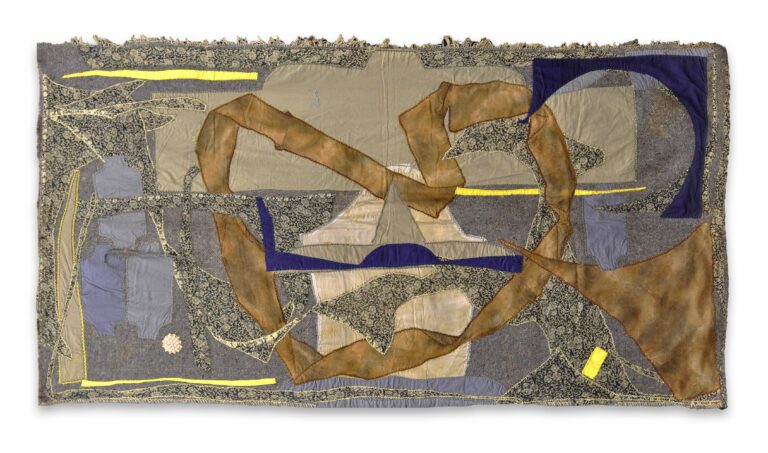
Noa Eshkol, Latrun Monastery, 2000s
© Noa Eshkol. Courtesy the artist and neugerriemschneider, Berlin. Photo: Jens Ziehe, Berlin
cotton, synthetic fiber, viscose
80 x 157 cm
Eshkol’s textile tableaux are, at their cores, tributes to their materials. While the predetermined forms of the offcuts, rags, scraps and panels that comprise them tease their once-intended use, they function within the wall carpets entirely independently of their prior utility. Rather than accepting or being limited by their prescribed roles, Eshkol instead brought an openness to her media, encountering them with new eyes each time. By assuming nothing, seeing these fragmented components as tools, she afforded herself a profound understanding of how they, in their present states, were to become sumptuous images. This approach, unburdened by preconceptions, enabled Eshkol to mold her workpieces into rich stories.
Vividly illustrated, the evocative scenes reflect a revelatory inclination to close observation that characterized both her fine-art and dance practices, and provide a forum for the diverse facets of her persona to enter dialog. While kept decidedly separate by Eshkol, these dual vocations inevitably came to share conceptual groundwork. Sets of guidelines and strict adherence to them stood at the forefront of each, giving rise to highly methodical series of systems – ones that concerned themselves with cataloging and deploying repetition to capture ephemeral moments.
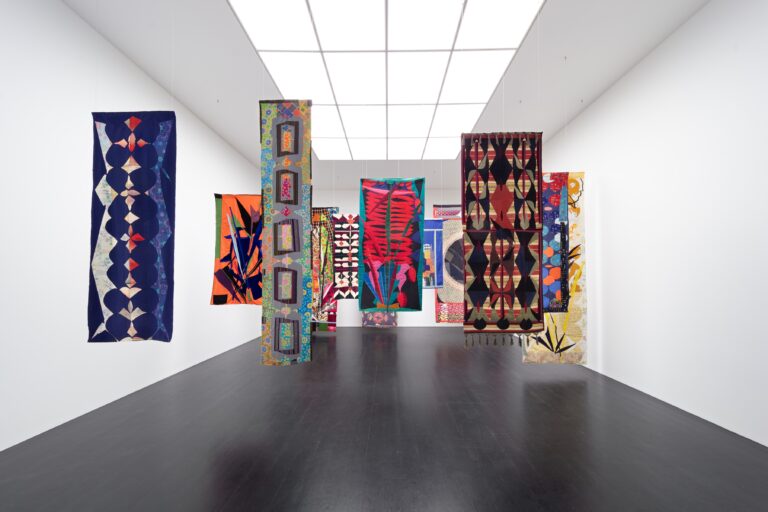
installation view: Noa Eshkol, textile traces, September 7, 2024 – March 15, 2025, neugerriemschneider, Berlin
© The Noa Eshkol Foundation for Movement Notation, Holon, Israel.
Courtesy The Noa Eshkol Foundation for Movement Notation, Holon, Israel, and neugerriemschneider, Berlin. Photo: Jens Ziehe, Berlin

Noa Eshkol, Geula’s Tree, 1990s
© Noa Eshkol. Courtesy the artist and neugerriemschneider, Berlin. Photo: Jens Ziehe, Berlin
synthetic fiber, cotton, wool
250 x 296 cm
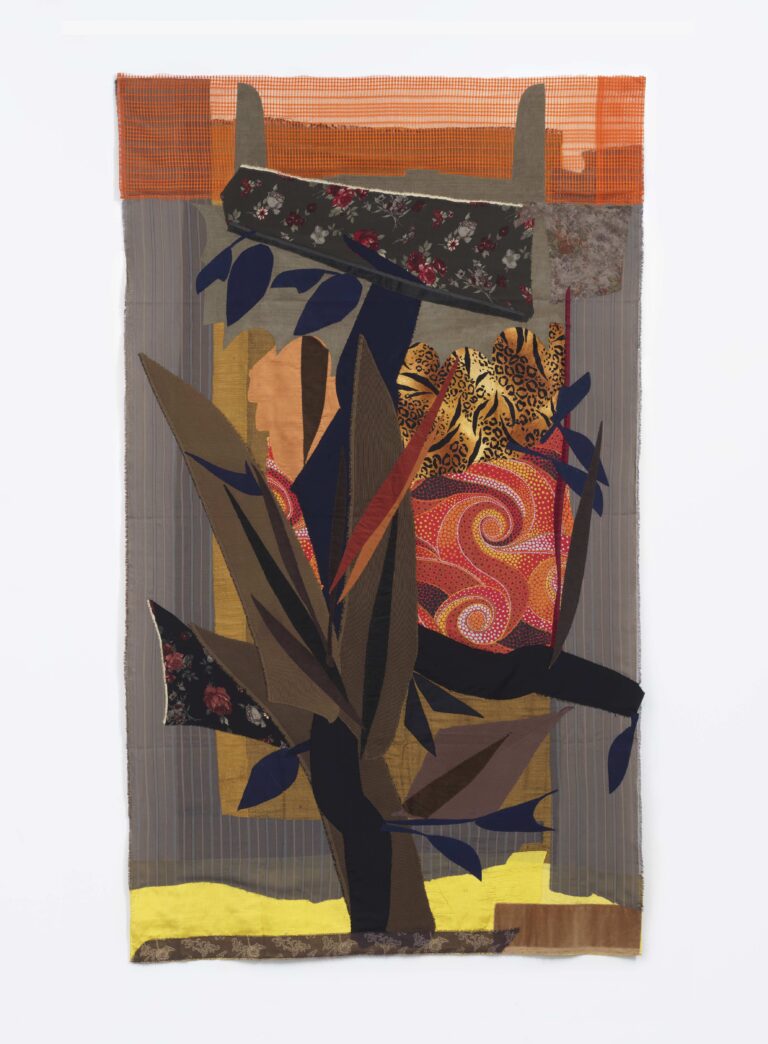
Noa Eshkol, Old Tree I , 1980s
© Noa Eshkol. Courtesy the artist and neugerriemschneider, Berlin. Photo: Jens Ziehe, Berlin
synthetic fiber, silk, cotton, viscose
279 x 167 cm
The suite of wall carpets presented showcases Eshkol’s world in a succession of expressive scenarios, a group of which is presented free-hanging to reveal the works’ utilitarian construction, traveling through dense depictions of forested wilds and abstracted interpretations of choreographic formations, before venturing into portrayals of natural phenomena and the cosmos. In Geula’s Tree (1990s), elongated strips of brown become a tree’s trunk and branches. Reaching upward, the limbs sprout tufts of autumn-toned foliage, while leaves in blues, greens and off-whites line their lengths. Strips of dark fabric, printed in florals and punctuated with ornamental bands, frame the tree, creating a boundary that in a single motion defines pictorial space and allows it to be transgressed. Nature gives way to orchestration in The Locomotive (1990s), which sees layered sequences of repeated circles mimic twirling dancers viewed from above. The spiraling forms create a sense of motion akin to the driving wheels of the self-propelled engine that lends the work its title. Motioning the viewer in towards its center, Planet (1998) ascends above the terrestrial plane, extending to the sky and beyond. A radial arrangement of patterned swatches emanates from the work’s middle, rippling outward and evoking a ringed celestial body. Four-pointed stars glinting in white are applied to the arrangement’s surface, imparting a depth to Eshkol’s spacescape and exemplifying the artist’s endless capacity for deftly crafting a distinct sense of place.

installation view: Noa Eshkol, textile traces, September 7, 2024 – March 15, 2025, neugerriemschneider, Berlin
© The Noa Eshkol Foundation for Movement Notation, Holon, Israel.
Courtesy The Noa Eshkol Foundation for Movement Notation, Holon, Israel, and neugerriemschneider, Berlin. Photo: Jens Ziehe, Berlin
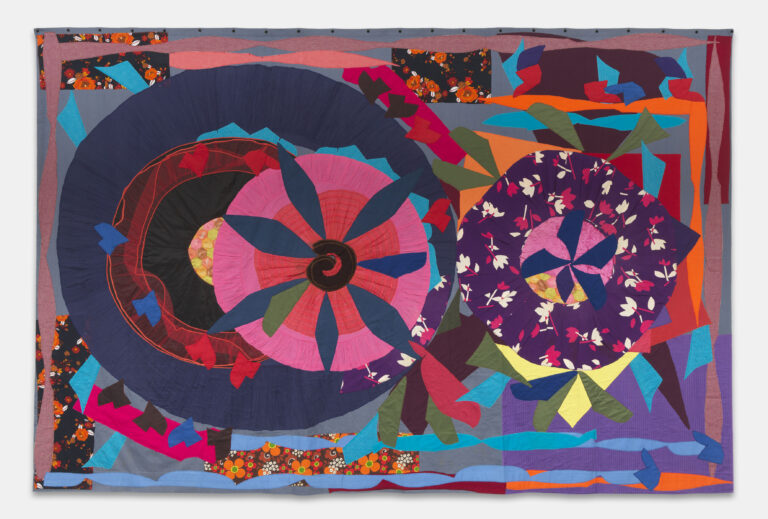
Noa Eshkol, The Locomotive , 1990s
© Noa Eshkol. Courtesy the artist and neugerriemschneider, Berlin. Photo: Jens Ziehe, Berlin
cotton, linen, wool, silk, tulle
272 x 411 cm
The artwork of Noa Eshkol (b. 1924, Degania Bet, Mandatory Palestine; d. 2007, Holon, Israel) has been the subject of international solo and group exhibitions at Georg Kolbe Museum, Berlin (2024); Norrköpings Konstmuseum, Norrköping (2022); Oslo Kunstforening, Oslo (2021); Casa do Povo, São Paulo (2021); 34th Bienal de São Paulo, São Paulo (2021); Van Abbemuseum, Eindhoven (2019); CFHILL Art Space, Stockholm (2019); Vleeshal, Middelburg (2017); 20th Biennale of Sydney, Sydney (2016); Badischer Kunstverein, Karlsruhe (2016); Museum of Contemporary Art Tokyo, Tokyo (2014); Kunst- und Kulturstiftung Opelvillen Rüsselsheim, Rüsselsheim (2013); TBA21 Thyssen-Bornemisza Art Contemporary, Vienna (2012); The Jewish Museum, New York (2012); Los Angeles County Museum of Art, Los Angeles (2012); The Israel Museum, Jerusalem (2011); Center for Contemporary Art, Tel Aviv (2011); The Open Museum, Tefen Industrial Park, Kfar Vradim (2010); Hamumche Gallery, Tel Aviv (1998); Mishkan Museum of Art, Ein Harod (1996); Danish Museum of Decorative Art, Copenhagen (1980); and Tel Aviv Museum of Art, Tel Aviv (1978).
This year, KW Institute for Contemporary Art and the Georg Kolbe Museum reissued Noa Eshkol and Avraham Wachman’s landmark 1958 publication “Movement Notation” for the first time since its initial release.
Cory Arcangel
Let’s Play Majerus G3
Cory Arcangel: AUDMCRS performed by lena willikens presented by Michel Majerus Estate
Silent Green
Gerichtstrasse 35, 13347 Berlin
12 SEP at 8 pm
Book launch & Conversation
with Cory Arcangel, Daniel Birnbaum and Stephanie Seidel
14 SEP 2024 at 12 pm
Michel Majerus Estate, Knaackstraße 12, 10405 Berlin
The Michel Majerus Estate is pleased to announce Let’s Play Majerus G3, a project featuring a previously unexplored aspect of the artist’s archive: his computer. An initiative led by artist Cory Arcangel, Let’s Play Majerus G3 takes as its point of departure the laptop that Majerus used in his late career, now reactivated following a restoration undertaken in cooperation with digital-art organization Rhizome.
By examining this crucial tool, Let’s Play Majerus G3 — an expansive program comprising the exhibition at the Michel Majerus Estate, a talk, a performance and a YouTube series — allows unprecedented access to Majerus’ digital studio and the approaches that informed it, representing a revolutionary development in the understanding of his oeuvre, and allowing a uniquely first-hand glimpse, through the eyes of a fellow artist, into this rich primary source.
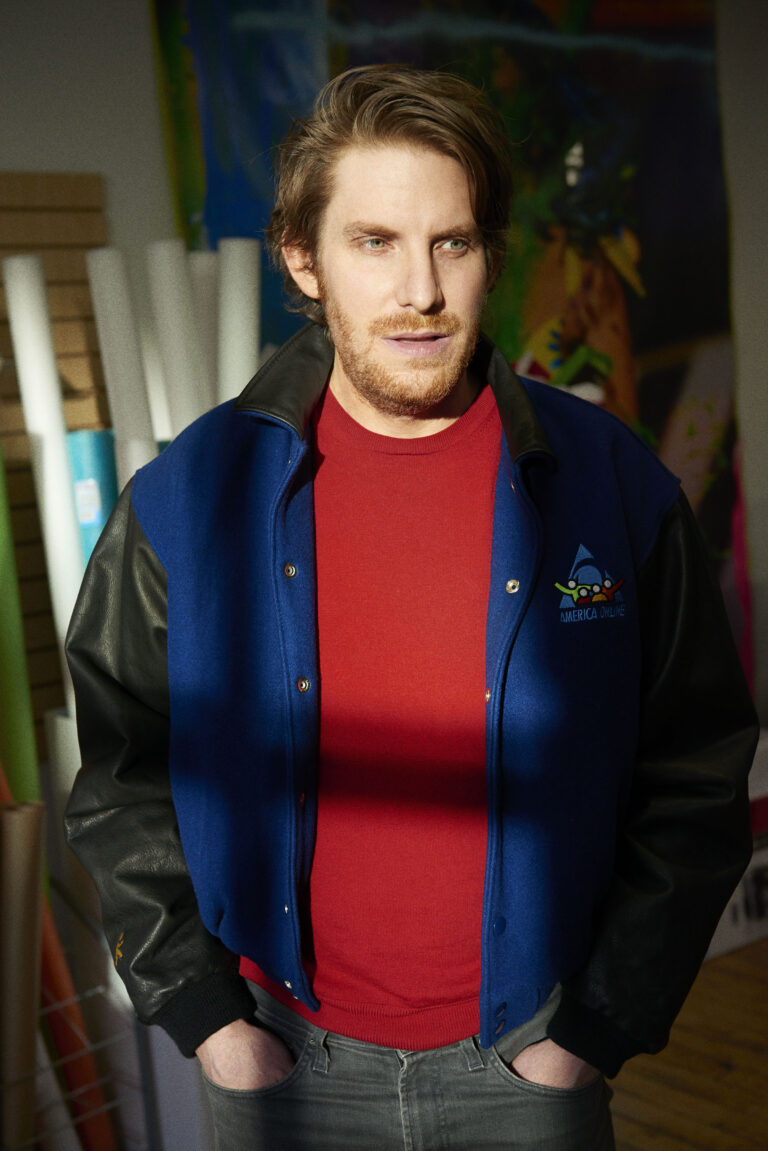
Cory Arcangel
Foto/ Photo: Tim Barber
As culture itself becomes increasingly digitized, more and more of it will end up in drawers like this — discarded, forgotten, and inoperable.
– Cory Arcangel in Artforum, summer 2014
While their respective practices began nearly a decade apart, and despite the disparate nature of their media, Majerus and Arcangel are united by a core interest in the aesthetics of digital imagery, the generative potential of new technologies, critique of said technologies and the free traversal of analog and digital worlds.
In 2022, Kunstverein in Hamburg staged Data Streaming, an exhibition that showcased a selection of late work by Majerus, and probed how the increasing presence of the digital in the late 1990s profoundly impacted his practice. On view concurrently with Arcangel’s presentation Flying Foxes, the pairing of shows brought the dialogue between the two artists to the fore, drawing attention to the brief moment in which their practices overlapped.


Bildschirmfoto einer Photoshop datei / Screenshot of photoshop file on Michel Majerus’ laptop (Powerbook G3)
Aufgenommen von / selected by Cory Arcangel, Nov. 2024
© Michel Majerus Estate, 2024

Bildschirmfoto einer Photoshop datei / Screenshot of photoshop file on Michel Majerus’ laptop (Powerbook G3)
Aufgenommen von / selected by Cory Arcangel, Nov. 2024
© Michel Majerus Estate, 2024
Using emulation developed by Dragan Espenschied and Mona Ulrich from Rhizome, Arcangel here reactivates Majerus’ laptop (a 1998 Macintosh PowerBook G3) — a tool that Majerus spent significant time with on a daily basis, conceiving works and exhibitions, assembling his schedule, conducting communication and experimenting with software. Arcangel’s project highlights Majerus’ use of the then-burgeoning internet, the scale, speed, accessibility and autonomy of which opened new doors for artists, and affords a singularly comprehensive look at his digital studio. Within the emulation environment, Majerus’ computer exists as the artist last used it, exactly as it stood in 2002, providing detailed insight into his process of conception, production and display, with files ranging from sketches of future works to exhibition views of them in their realized forms.
Arcangel’s work is driven by the temporality and technological dependence of aesthetics, with modern-day technology constituting, in a broad sense, a key advancement in human history — a chronology that includes everything from musical instruments of the Renaissance to contemporary video games. Among a generation of artists distinguished by the integration of new media in their practices, Arcangel’s early negotiation of a digital present stands as exceptional.
His engagement with archival computing here builds upon a 2014 project in which he, together with several organizations including the Carnegie Mellon Computer Club — a team specializing in obsolete computers — accessed over 30-year-old floppy discs from the collection of the Andy Warhol Museum in Pittsburgh, rescuing a group of long-lost digital works by the artist.
The project at the Michel Majerus Estate, in exploring and presenting Majerus’ computer, foregrounds the technological challenge of re-accessing a wealth of information thought to be lost. It lends consideration to the increasingly prominent role of archiving digital materials and interrogates the ways in which these holdings crucially factor into authoring arthistorical narratives surrounding 21st-century protagonists.
Let’s Play Majerus G3 is accompanied by an in-person and online program. The exhibition at the Michel Majerus Estate features works by Arcangel that span nearly two decades, including new commissions displayed alongside selected works by Majerus in a juxtaposition that suggests a continuity in non-concurrent, albeit conceptually linked, bodies of work.
On YouTube, Arcangel — in his debut as a “YouTuber” — posts “Let’s Play” videos that feature him as he navigates Majerus’ computer as part of this project. These videos are also presented on the Michel Majerus Estate’s website and by Rhizome as part of their series of presentations on digital-art archival, “ArtBase Anthologies.”
The project is accompanied by a conversation between Cory Arcangel and Dragan Espenschied during Gallery Weekend Berlin, followed by a new iteration of Arcangel’s performance The AUDMCRS Underground Dance Music Collection of Recorded Sound (2015 – ongoing) in fall 2024, and a series of events with Rhizome conducted over the course of the exhibition.


Bildschirmfoto einer Photoshop datei / Screenshot of photoshop file on Michel Majerus’ laptop (Powerbook G3)
Aufgenommen von / selected by Cory Arcangel, Nov. 2023
© Michel Majerus Estate, 2024

Bildschirmfoto des Desktops von / Screenshot of photoshop file on Michel Majerus’ laptop (Powerbook G3)
Aufgenommen von / selected by Cory Arcangel, Nov. 2023
© Michel Majerus Estate, 2024
Let’s Play: Majerus G3 was created in cooperation with Rhizome, an artist-founded platform for presenting, researching, and preserving digital art. The emulation of Majerus’ computer, developed by OpenSLX, was overseen by Dragan Espenschied (Preservation Director at Rhizome) and Mona Ulrich. The project is supported by grants from the Institute for Contemporary Art Research (IFCAR), awarded by the Zurich University of the Arts, where Arcangel currently teaches; and from Arcangel Surfware, a software and merchandise publisher founded by Arcangel in 2014.
Cory Arcangel (b. 1978, Buffalo, US) is an artist living and working in Stavanger, Norway. His work has been the subject of solo exhibitions at Kunstverein in Hamburg, Hamburg (2022); Whitney Museum of American Art, New York (2011); Carnegie Museum of Art, Pittsburgh (2012); The Barbican, London (2011); Reykjavik Art Museum, Iceland (2015); Hamburger Bahnhof — Museum für Gegenwart, Berlin (2010); Museum of Contemporary Art, North Miami (2010) and Migros Museum für Gegenwartskunst, Zurich (2005).
Rhizome champions born-digital art and culture through commissions, exhibitions, scholarship and digital art conservation. Founded in 1996 by artist Mark Tribe as an email discussion list including some of the first artists to work online, Rhizome has played an integral role in the history of contemporary art engaged with digital technologies and the internet. Since 2003, Rhizome has been an affiliate in residence at the New Museum in New York City.
Housed in the artist’s former studio, the Michel Majerus Estate is dedicated to researching, presenting and contextualizing the work of Michel Majerus (1967 – 2002), and preserving the cultural legacy of an extensive oeuvre created during a short period that began in the late 1980s. In this time, he developed a pioneering visual language that freely drew upon subcultures, mass media, nascent digital technologies and a wide array of arthistorical sources, sampling their component parts and reintegrating them into his compositions and installations. Since 2012, the Michel Majerus Estate has invited guest curators, scholars and artists to engage with Majerus’ practice through exhibitions and projects staged at the Estate. Previous collaborators include Brigitte Franzen, Fabian Schöneich, Joseph Kosuth, Laura Owens and Jordan Wolfson.















